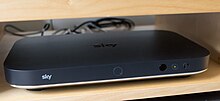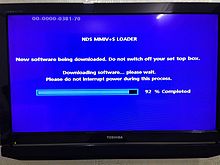Set-top box


A set-top box (STB), also known as a
According to the
TV signal sources
The signal source might be an
UHF converter
Before the
Cable converter
These frequencies corresponded to non-television services (such as two-way radio) over the air and were therefore not on standard TV receivers. Before cable-ready TV sets became common in the late 1980s, an electronic tuning device called a
Newer television receivers greatly reduced the need for external set-top boxes, although
Closed captioning box
Set-top boxes were also made to enable
Digital television adapter
The
Professional set-top box
Professional set-top boxes are referred to as IRDs or integrated receiver/decoders in the professional broadcast audio/video industry. They are designed for more robust field handling and rack mounting environments. IRDs are capable of outputting uncompressed serial digital interface signals, unlike consumer STBs which usually do not, mostly because of copyright reasons.
Hybrid box

Hybrid set-top boxes, such as those used for
As examples, Hybrid Broadcast Broadband TV (HbbTV) set-top boxes allow traditional TV broadcasts, whether from terrestrial (DTT), satellite, or cable providers, to be brought together with video delivered over the Internet and personal multimedia content. Advanced Digital Broadcast (ADB) launched its first hybrid DTT/IPTV set-top box in 2005,[5] which provided Telefónica with the digital TV platform for its Movistar TV service by the end of that year.[6] In 2009, ADB provided Europe's first three-way hybrid digital TV platform to Polish digital satellite operator n, which enables subscribers to view integrated content whether delivered via satellite, terrestrial, or internet.[7]
UK-based
IPTV receiver
In
In the US and Europe, telephone companies use IPTV (often on
This type of service is distinct from
Features
Programming features
Electronic program guide
Favorites
This feature allows the user to choose preferred channels, making them easier and quicker to access; this is handy with the wide range of digital channels on offer. The concept of favourite channels is superficially similar to that of the "bookmark" function offered in many web browsers.
Timer
The timer allows the user to program and enable the box to switch between channels at certain times: this is handy to record from more than one channel while the user is out. The user still needs to program the VCR or DVD recorder.
Convenience features
Controls on the box
Some models have controls on the box, as well as on the remote control. This is useful should the user lose the remote or if the batteries age.
Remote controls that work with other TVs
Some remote controls can also control some basic functions of various brands of TVs. This allows the user to use just one remote to turn the TV on and off, adjust volume, or switch between digital and analogue TV channels or between terrestrial and internet channels.
Parental locks
The parental lock or content filters allow users over 18 years old to block access to channels that are not appropriate for children, using a personal identification number. Some boxes simply block all channels, while others allow the user to restrict access to chosen channels not suitable for children below certain ages.
Software alternatives
As complexity and potential programming faults of the set-top box increase,[10] software such as MythTV, Select-TV and Microsoft's Media Center have developed features comparable to those of set-top boxes, ranging from basic DVR-like functionality to DVD copying, home automation, and housewide music or video playback.
Firmware update features

Almost all modern set-top boxes feature automatic firmware update processes. The firmware update is typically provided by the service provider.
Ambiguities in the definition
With the advent of flat-panel televisions, set-top boxes are now deeper in profile than the tops of most modern TV sets. Because of this, set-top boxes are often placed beneath televisions, and the term set-top box has become something of a misnomer, possibly helping the adoption of the term digibox. Additionally, newer set-top boxes that sit at the edge of IP-based distribution networks are often called net-top boxes or NTBs, to differentiate between IP and RF inputs. The Roku LT is around the size of a pack of cards and delivers Smart TV to conventional sets.[11]
The distinction between external tuner or
Devices with the capabilities of
Europe
In Europe, a set-top box does not necessarily contain a tuner of its own. A box connected to a television (or VCR) SCART connector is fed with the baseband television signal from the set's tuner, and can have the television display the returned processed signal instead.
This SCART feature had been used for connection to analogue decoding equipment by
In case of analogue pay-TV, this approach avoided the need for a second
Energy use
In June 2011 a report from the American National Resources Defense Council brought attention to the
See also
- AllVid
- CableCARD
- Comparison of digital media players
- DTV receiver
- Digital media player
- Microconsole
- Over-the-top media service
References
- ^ https://www.worldradiohistory.com/Archive-C-ED/80s/C-ED-1981-12.pdf
- ^ Lazarus, David (2018-10-30). "How much does a cable box really cost? The industry would prefer you don't ask". Los Angeles Times. Retrieved 2023-08-13.
- ^ "Welcome to Inview". Inview Technology. 2013-07-26. Archived from the original on 2013-08-01.
- ^ "Webcasts". Archived from the original on 2010-04-05. Retrieved 2010-06-02.
- ^ "About – DVB". dvb.org. Archived from the original on 6 June 2013. Retrieved 28 April 2018.
- ^ "ADB Delivers World's First Hybrid, Single-Chip, Advanced Video Coding, High Definition IPTV Set-Top Boxes To Telefónica". digitaltvnews.net. September 11, 2006. Archived from the original on 2012-02-27. Retrieved 2013-06-15.
- ^ "ADB takes 'n' hybrid". broadbandtvnews.com. 12 September 2009. Archived from the original on 4 July 2017. Retrieved 28 April 2018.
- ^ New global standard for fully networked home Archived 2009-02-21 at the Wayback Machine, ITU-T Press Release
- ^ "Today - TV Guide". itv.com. Archived from the original on 1 December 2017. Retrieved 28 April 2018.
- ^ "The Chimera of Software Quality". Archived from the original on 2018-04-28. 080322 computer.org
- ^ Which? Consumer's Guide; October 2012; page 41
- ^ "settopboxes.pdf" (PDF). Archived (PDF) from the original on 2012-02-25. Retrieved 2012-02-25. Natural Resources Defense Council.
- ^ "Cable Boxes and DVRs: Can Appliance Standards Help Tame These Hidden Energy Hogs?". Archived from the original on 2012-01-29. Retrieved 2012-02-25. Environmental and Energy Study Institute
- ^ "U.S. Cable Industry Launches New Energy Efficiency Initiative". Archived from the original on 2012-05-12. Retrieved 2012-04-20.
External links
- "What Is a Set Top Box or STB Working and Architecture?" at Headendinfo.com
